2018 HYUNDAI I10 warning
[x] Cancel search: warningPage 3 of 343
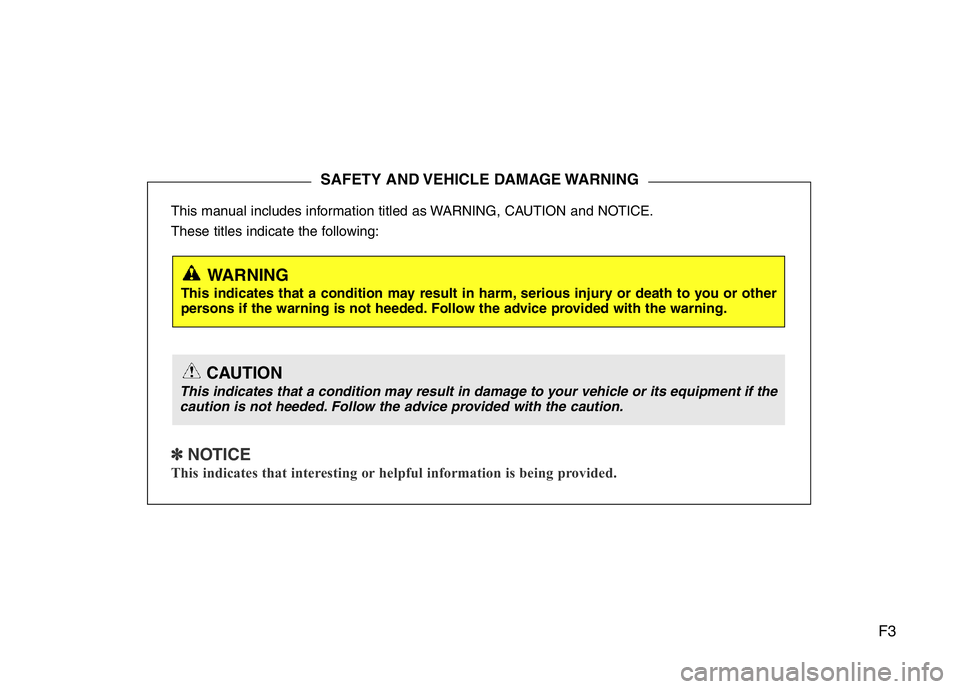
F3
This manual includes information titled as WARNING, CAUTION and NOTICE.
These titles indicate the following:
✽ NOTICE
This indicates that interesting or helpful information is being provided.
SAFETY AND VEHICLE DAMAGE WARNING
WARNING
This indicates that a condition may result in harm, serious injury or death to you or other
persons if the warning is not heeded. Follow the advice provided with the warning.
CAUTION
This indicates that a condition may result in damage to your vehicle or its equipment if the
caution is not heeded. Follow the advice provided with the caution.
Page 7 of 343
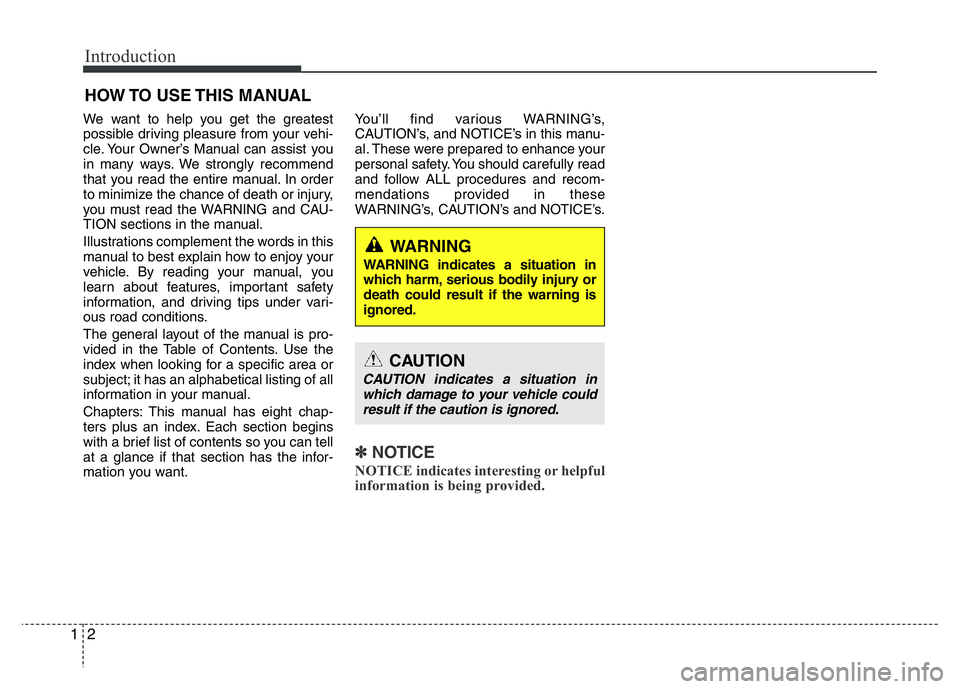
Introduction
2 1
We want to help you get the greatest
possible driving pleasure from your vehi-
cle. Your Owner’s Manual can assist you
in many ways. We strongly recommend
that you read the entire manual. In order
to minimize the chance of death or injury,
you must read the WARNING and CAU-
TION sections in the manual.
Illustrations complement the words in this
manual to best explain how to enjoy your
vehicle. By reading your manual, you
learn about features, important safety
information, and driving tips under vari-
ous road conditions.
The general layout of the manual is pro-
vided in the Table of Contents. Use the
index when looking for a specific area or
subject; it has an alphabetical listing of all
information in your manual.
Chapters: This manual has eight chap-
ters plus an index. Each section begins
with a brief list of contents so you can tell
at a glance if that section has the infor-
mation you want.You’ll find various WARNING’s,
CAUTION’s, and NOTICE’s in this manu-
al. These were prepared to enhance your
personal safety. You should carefully read
and follow ALL procedures and recom-
mendations provided in these
WARNING’s, CAUTION’s and NOTICE’s.
✽ NOTICE
NOTICE indicates interesting or helpful
information is being provided.
HOW TO USE THIS MANUAL
WARNING
WARNING indicates a situation in
which harm, serious bodily injury or
death could result if the warning is
ignored.
CAUTION
CAUTION indicates a situation in
which damage to your vehicle could
result if the caution is ignored.
Page 8 of 343

13
Introduction
Unleaded
Your new vehicle is designed to use only
unleaded fuel having an Octane Rating
of RON (Research Octane Number) 91 /
AKI (Anti-Knock Index) 87 or higher.
Your new vehicle is designed to obtain
maximum performance with UNLEADED
FUEL, as well as minimize exhaust emis-
sions and spark plug fouling.
Leaded (if equipped)
For some countries, your vehicle is
designed to use leaded gasoline. When
you are going to use leaded gasoline, we
recommend that you ask an authorzied
HYUNDAI dealer whether leaded gaso-
line in your vehicle is available or not.
Octane Rating of leaded gasoline is
same with unleaded one.
FUEL REQUIREMENTS
CAUTION
NEVER USE LEADED FUEL. The
use of leaded fuel is detrimental to
the catalytic converter and will
damage the engine control sys-
tem’s oxygen sensor and affect
emission control.
Never add any fuel system cleaning
agents to the fuel tank other than
what has been specified. (We rec-
ommend that you contact an
authorized HYUNDAI dealer for
details)
WARNING
• Do not "top off" after the nozzle
automatically shuts off when
refueling.
• Always check that the fuel cap is
installed securely to prevent fuel
spillage in the event of an acci-
dent.
Page 14 of 343
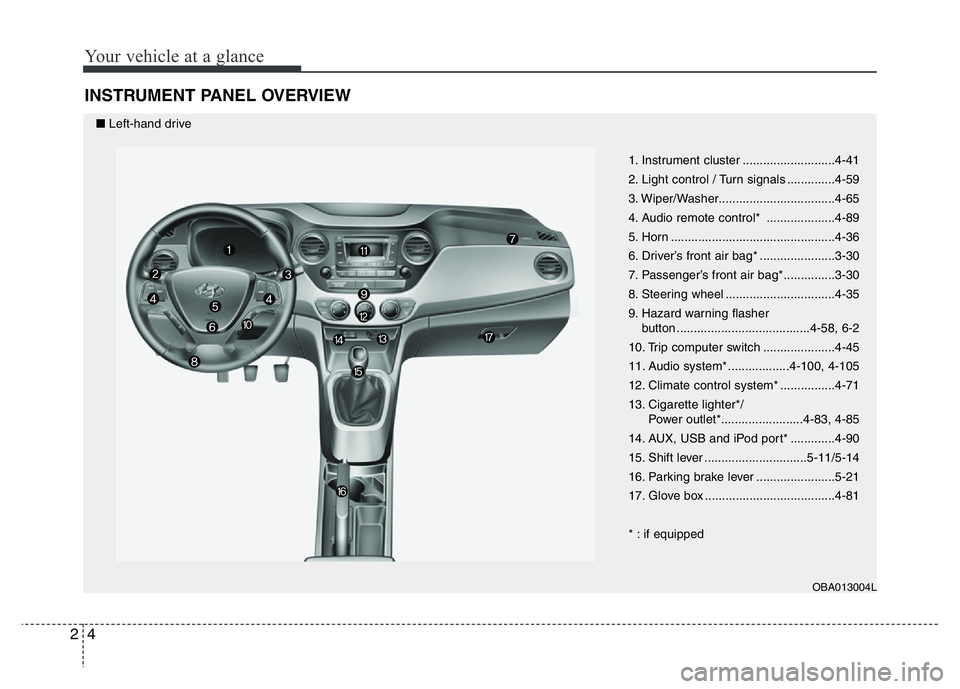
Your vehicle at a glance
4 2
INSTRUMENT PANEL OVERVIEW
1. Instrument cluster ...........................4-41
2. Light control / Turn signals ..............4-59
3. Wiper/Washer..................................4-65
4. Audio remote control* ....................4-89
5. Horn ................................................4-36
6. Driver’s front air bag* ......................3-30
7. Passenger’s front air bag*...............3-30
8. Steering wheel ................................4-35
9. Hazard warning flasher
button .......................................4-58, 6-2
10. Trip computer switch .....................4-45
11. Audio system* ..................4-100, 4-105
12. Climate control system* ................4-71
13. Cigarette lighter*/
Power outlet*........................4-83, 4-85
14. AUX, USB and iPod port* .............4-90
15. Shift lever ..............................5-11/5-14
16. Parking brake lever .......................5-21
17. Glove box ......................................4-81
* : if equipped
OBA013004L
■Left-hand drive
Page 15 of 343
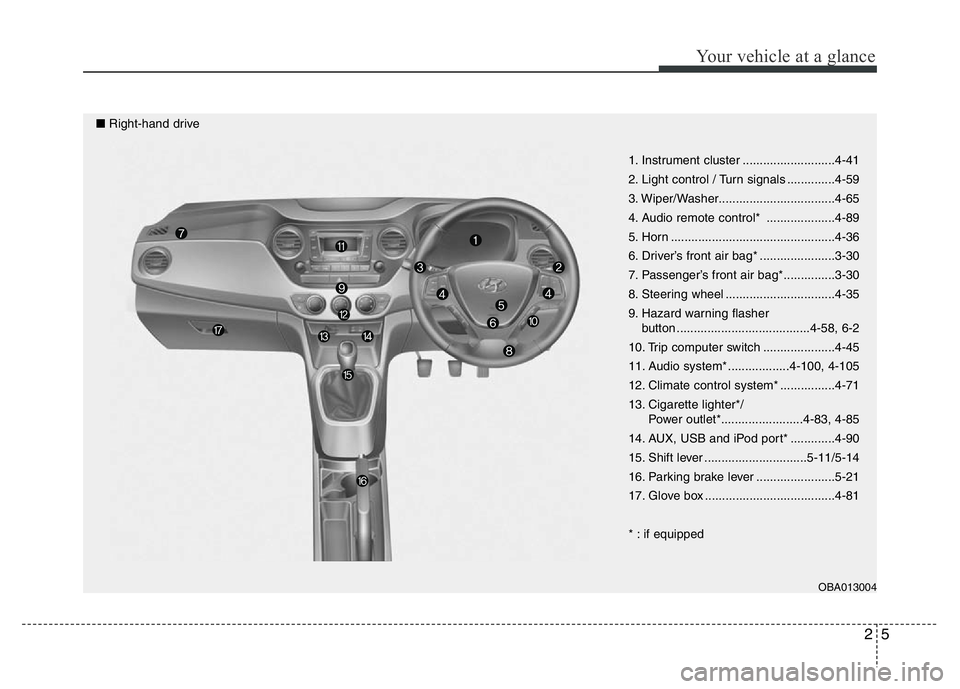
25
Your vehicle at a glance
1. Instrument cluster ...........................4-41
2. Light control / Turn signals ..............4-59
3. Wiper/Washer..................................4-65
4. Audio remote control* ....................4-89
5. Horn ................................................4-36
6. Driver’s front air bag* ......................3-30
7. Passenger’s front air bag*...............3-30
8. Steering wheel ................................4-35
9. Hazard warning flasher
button .......................................4-58, 6-2
10. Trip computer switch .....................4-45
11. Audio system* ..................4-100, 4-105
12. Climate control system* ................4-71
13. Cigarette lighter*/
Power outlet*........................4-83, 4-85
14. AUX, USB and iPod port* .............4-90
15. Shift lever ..............................5-11/5-14
16. Parking brake lever .......................5-21
17. Glove box ......................................4-81
* : if equipped
OBA013004
■Right-hand drive
Page 17 of 343
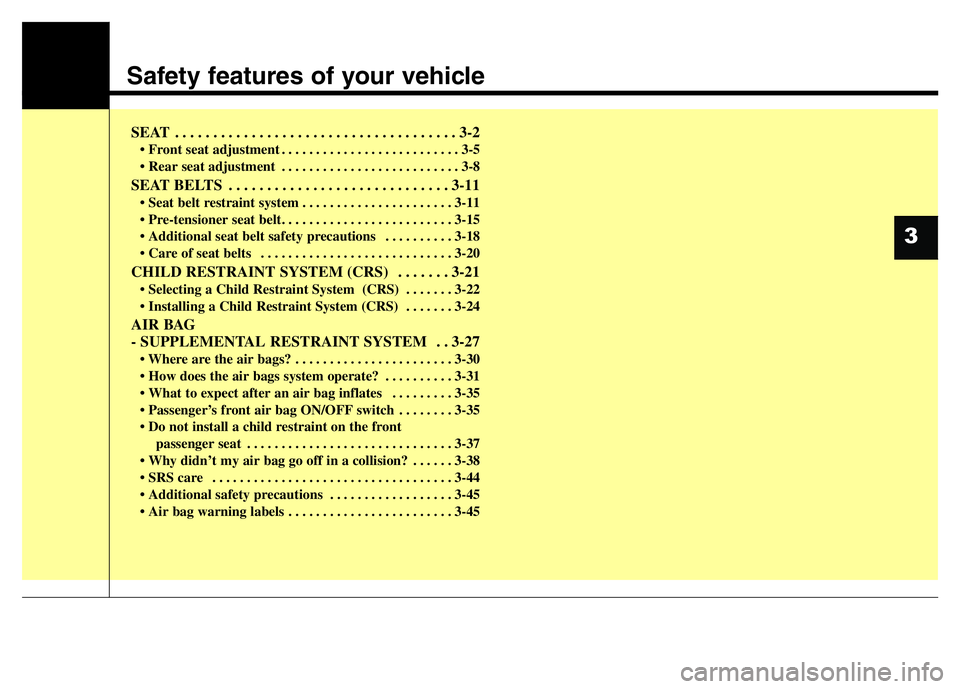
Safety features of your vehicle
SEAT . . . . . . . . . . . . . . . . . . . . . . . . . . . . . . . . . . . . . 3-2
• Front seat adjustment . . . . . . . . . . . . . . . . . . . . . . . . . . 3-5
• Rear seat adjustment . . . . . . . . . . . . . . . . . . . . . . . . . . 3-8
SEAT BELTS . . . . . . . . . . . . . . . . . . . . . . . . . . . . . 3-11
• Seat belt restraint system . . . . . . . . . . . . . . . . . . . . . . 3-11
• Pre-tensioner seat belt. . . . . . . . . . . . . . . . . . . . . . . . . 3-15
• Additional seat belt safety precautions . . . . . . . . . . 3-18
• Care of seat belts . . . . . . . . . . . . . . . . . . . . . . . . . . . . 3-20
CHILD RESTRAINT SYSTEM (CRS) . . . . . . . 3-21
• Selecting a Child Restraint System (CRS) . . . . . . . 3-22
• Installing a Child Restraint System (CRS) . . . . . . . 3-24
AIR BAG
- SUPPLEMENTAL RESTRAINT SYSTEM . . 3-27
• Where are the air bags? . . . . . . . . . . . . . . . . . . . . . . . 3-30
• How does the air bags system operate? . . . . . . . . . . 3-31
• What to expect after an air bag inflates . . . . . . . . . 3-35
• Passenger’s front air bag ON/OFF switch . . . . . . . . 3-35
• Do not install a child restraint on the front
passenger seat . . . . . . . . . . . . . . . . . . . . . . . . . . . . . . 3-37
• Why didn’t my air bag go off in a collision? . . . . . . 3-38
• SRS care . . . . . . . . . . . . . . . . . . . . . . . . . . . . . . . . . . . 3-44
• Additional safety precautions . . . . . . . . . . . . . . . . . . 3-45
• Air bag warning labels . . . . . . . . . . . . . . . . . . . . . . . . 3-45
3
Page 20 of 343
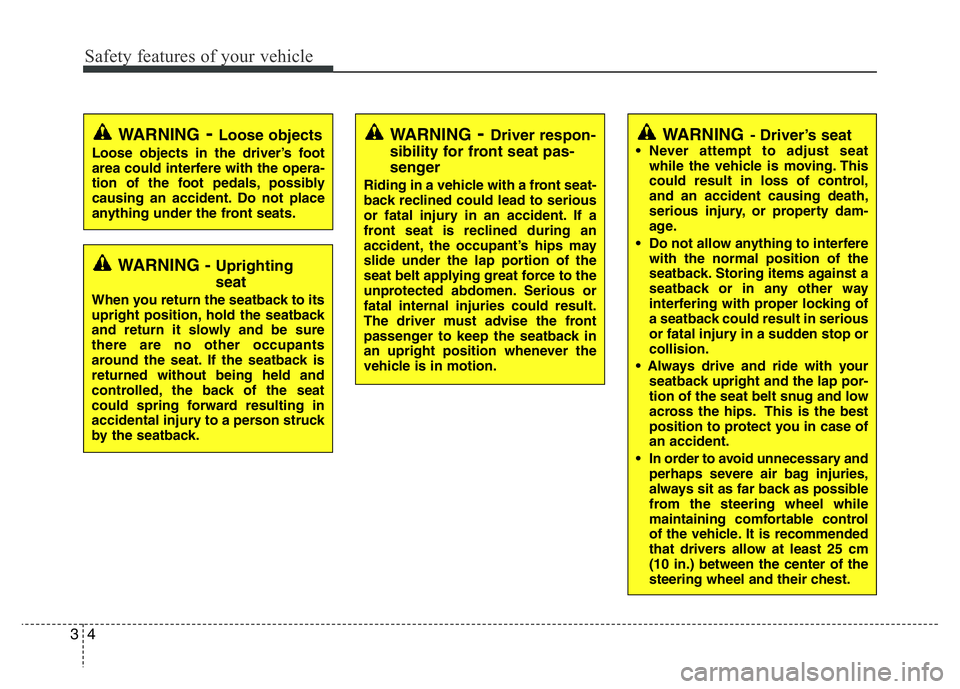
Safety features of your vehicle
4 3
WARNING- Driver’s seat• Never attempt to adjust seat
while the vehicle is moving. This
could result in loss of control,
and an accident causing death,
serious injury, or property dam-
age.
• Do not allow anything to interfere
with the normal position of the
seatback. Storing items against a
seatback or in any other way
interfering with proper locking of
a seatback could result in serious
or fatal injury in a sudden stop or
collision.
• Always drive and ride with your
seatback upright and the lap por-
tion of the seat belt snug and low
across the hips. This is the best
position to protect you in case of
an accident.
• In order to avoid unnecessary and
perhaps severe air bag injuries,
always sit as far back as possible
from the steering wheel while
maintaining comfortable control
of the vehicle. It is recommended
that drivers allow at least 25 cm
(10 in.) between the center of the
steering wheel and their chest.
WARNING - Uprighting
seat
When you return the seatback to its
upright position, hold the seatback
and return it slowly and be sure
there are no other occupants
around the seat. If the seatback is
returned without being held and
controlled, the back of the seat
could spring forward resulting in
accidental injury to a person struck
by the seatback.
WARNING- Loose objects
Loose objects in the driver’s foot
area could interfere with the opera-
tion of the foot pedals, possibly
causing an accident. Do not place
anything under the front seats.
WARNING- Driver respon-
sibility for front seat pas-
senger
Riding in a vehicle with a front seat-
back reclined could lead to serious
or fatal injury in an accident. If a
front seat is reclined during an
accident, the occupant’s hips may
slide under the lap portion of the
seat belt applying great force to the
unprotected abdomen. Serious or
fatal internal injuries could result.
The driver must advise the front
passenger to keep the seatback in
an upright position whenever the
vehicle is in motion.
Page 22 of 343

Safety features of your vehicle
6 3
Headrest
The driver's and front passenger's seats
are equipped with a headrest for the
occupant's safety and comfort.
The headrest not only provides comfort
for the driver and front passenger, but
also helps protect the head and neck in
the event of a collision.Adjusting the height up and down
(if equipped)
To raise the headrest, pull it up to the
desired position (1). To lower the head-
rest, push and hold the release button (2)
on the headrest support and lower the
headrest to the desired position (3).
OPA039052
WARNING
To reduce the risk of serious injury
or death in an accident, take the fol-
lowing precautions when adjusting
your headrests:
• Always properly adjust the head-
rests for all passengers BEFORE
starting the vehicle.
• NEVER let anyone ride in a seat
with the headrest removed.
• Adjust the headrests so the mid-
dle of the headrests is at the
same height as the height of the
top of the eyes (see diagram).
• NEVER adjust the headrest posi-
tion of the driver's seat when the
vehicle is in motion.
• Adjust the headrest as close to
the passenger's head as possi-
ble. Do not use a seat cushion
that holds the body away from
the seatback.
OBA033005